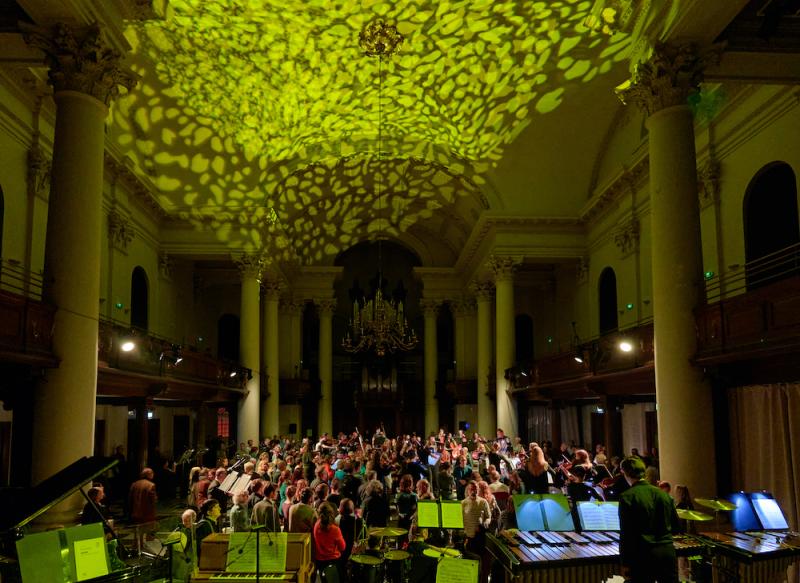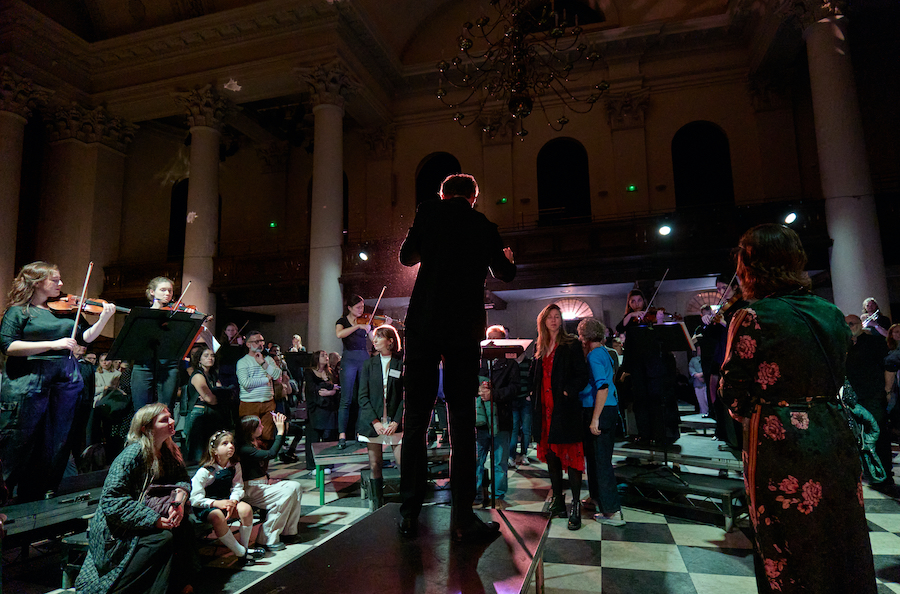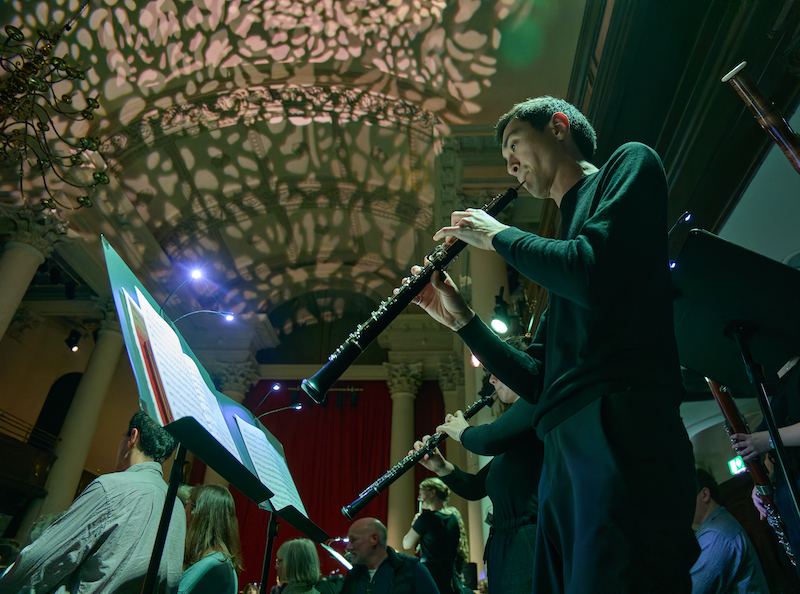The Orchestral Forest, Smith Square Hall review - living the orchestra from the inside | reviews, news & interviews
The Orchestral Forest, Smith Square Hall review - living the orchestra from the inside
The Orchestral Forest, Smith Square Hall review - living the orchestra from the inside
Immersive concert explores the plight of the British rainforest through music

What’s it like to be in the middle of an orchestra, hugger-mugger with the violas, looking directly over the flautist’s shoulder? Last night’s immersive concert by Sinfonia Smith Square gave the us the chance to find out, the players spread around Smith Square Hall on podiums, with the audience encouraged to wander round as the performance unfolded. It was at once a revealing but also somewhat frustrating experience.
The hour-long programme explored the plight of the UK’s temperate rainforest. You may not (I didn’t) realise the UK had any temperate rainforest, but it does – and centuries ago it occupied 20% of the country’s area. That is now 0.07%. Sound designer Matt Belcher gave us slightly New Age “sounds of the rainforest” audio between the musical items, with some narration about efforts to save what is left of it. At one point we heard a powersaw cutting down a tree, at which point the players slowly descended to the floor, in a slightly eggy, GCSE Drama moment, only to rise again for the final item.
The music followed a similar contour. Dobrinka Tabakova’s The Patience of Trees, a mini-violin concerto, is has a broadly uplifting shape, from an inchoate opening out of which soloist Emma Purslow’s insistent figuration emerged. Mendelssohn’s Midsummer Night’s Dream Overture is likewise life-affirming. Vagn Holmboe’s peculiar Prelude to the Pollution of Nature initiated the sense of decline only for Nadia Boulanger’s piano solo Vers la vie nouvelle (beautifully played by Zeynep Özsuca Rattle) to mark a re-ascendancy, which was rounded off by Michael Nyman’s assertive Strong of Oaks, Strong on the Causes of Oaks. This musical narrative was the concert’s biggest strength, paced very effectively by conductor Maxime Tortelier (pictured above by Sophie Oliver) who managed to find some interpretative subtlety (above all in the Tabakova) while he was, by necessity, at times something of a director-of-traffic. And this comes to the biggest problem: it is difficult enough getting an orchestra to play together when they are seated alongside each other, and tight ensemble becomes nigh-on impossible when the players are dispersed and punters are constantly wandering through the sightlines.
This musical narrative was the concert’s biggest strength, paced very effectively by conductor Maxime Tortelier (pictured above by Sophie Oliver) who managed to find some interpretative subtlety (above all in the Tabakova) while he was, by necessity, at times something of a director-of-traffic. And this comes to the biggest problem: it is difficult enough getting an orchestra to play together when they are seated alongside each other, and tight ensemble becomes nigh-on impossible when the players are dispersed and punters are constantly wandering through the sightlines.
And some of the music was particularly unforgiving in this regard. The fast violin passagework of the Mendelssohn, the arpeggiated figuration of the second movement of the Tabakova, the finale of the Nyman: in the best circumstances these would all be difficult to get together, and here they often weren’t. But this isn’t to dismiss the (excellent) players or the project altogether: for everything that was lost in rhythmic unanimity there was a gain for the audience member getting a unique insight into the musical innards. This was most obvious in the Mendelssohn, where the familiarity of the piece meant the fresh perspectives were all the fresher. I spent some time by the violas, and by the basses, and heard things I’d never heard before. Less successful was standing by the timpani – you could hear little else – or the horns. Some people opted to sit at the periphery, for a more normally balanced sound, and I can understand that, but for me it was best enjoyed by moving from place to place. Most exhilarating was standing between the conductor and the strings, enjoying literal surround-sound.
This was most obvious in the Mendelssohn, where the familiarity of the piece meant the fresh perspectives were all the fresher. I spent some time by the violas, and by the basses, and heard things I’d never heard before. Less successful was standing by the timpani – you could hear little else – or the horns. Some people opted to sit at the periphery, for a more normally balanced sound, and I can understand that, but for me it was best enjoyed by moving from place to place. Most exhilarating was standing between the conductor and the strings, enjoying literal surround-sound.
Sinfonia Smith Square – until recently the Southbank Sinfonia – is an ensemble for young professionals, and this toying with concert protocols is absolutely something they should be doing. And the audience was notably younger than for most orchestral concerts. The music choices were obviously driven by the theme, otherwise I’m not sure that Nyman’s Strong on Oaks… would really be worthy of programming. It’s not one of his best. Likewise the Holmboe, oddly disjointed, is not something I will rush to hear again. But the Tabakova, with its echoes of Vaughan Williams and Arvo Pärt, held the attention, and the Mendelssohn is as evergreen as the trees in the forest.
rating
Explore topics
Share this article
The future of Arts Journalism
You can stop theartsdesk.com closing!
We urgently need financing to survive. Our fundraising drive has thus far raised £49,000 but we need to reach £100,000 or we will be forced to close. Please contribute here: https://gofund.me/c3f6033d
And if you can forward this information to anyone who might assist, we’d be grateful.

Subscribe to theartsdesk.com
Thank you for continuing to read our work on theartsdesk.com. For unlimited access to every article in its entirety, including our archive of more than 15,000 pieces, we're asking for £5 per month or £40 per year. We feel it's a very good deal, and hope you do too.
To take a subscription now simply click here.
And if you're looking for that extra gift for a friend or family member, why not treat them to a theartsdesk.com gift subscription?
more Classical music
 Hallé John Adams festival, Bridgewater Hall / RNCM, Manchester review - standing ovations for today's music
From 1980 to 2025 with the West Coast’s pied piper and his eager following
Hallé John Adams festival, Bridgewater Hall / RNCM, Manchester review - standing ovations for today's music
From 1980 to 2025 with the West Coast’s pied piper and his eager following
 Kaploukhii, Greenwich Chamber Orchestra, Cutts, St James's Piccadilly review - promising young pianist
A robust and assertive Beethoven concerto suggests a player to follow
Kaploukhii, Greenwich Chamber Orchestra, Cutts, St James's Piccadilly review - promising young pianist
A robust and assertive Beethoven concerto suggests a player to follow
 Robin Holloway: Music's Odyssey review - lessons in composition
Broad and idiosyncratic survey of classical music is insightful but slightly indigestible
Robin Holloway: Music's Odyssey review - lessons in composition
Broad and idiosyncratic survey of classical music is insightful but slightly indigestible
 Classical CDs: Wolf-pelts, clowns and social realism
British ballet scores, 19th century cello works and contemporary piano etudes
Classical CDs: Wolf-pelts, clowns and social realism
British ballet scores, 19th century cello works and contemporary piano etudes
 Bizet in 150th anniversary year: rich and rare French offerings from Palazzetto Bru Zane
Specialists in French romantic music unveil a treasure trove both live and on disc
Bizet in 150th anniversary year: rich and rare French offerings from Palazzetto Bru Zane
Specialists in French romantic music unveil a treasure trove both live and on disc
 Scottish Chamber Orchestra, Ibragimova, Queen’s Hall, Edinburgh review - rarities, novelties and drumrolls
A pity the SCO didn't pick a better showcase for a shining guest artist
Scottish Chamber Orchestra, Ibragimova, Queen’s Hall, Edinburgh review - rarities, novelties and drumrolls
A pity the SCO didn't pick a better showcase for a shining guest artist
 Kilsby, Parkes, Sinfonia of London, Wilson, Barbican review - string things zing and sing in expert hands
British masterpieces for strings plus other-worldly tenor and horn - and a muscular rarity
Kilsby, Parkes, Sinfonia of London, Wilson, Barbican review - string things zing and sing in expert hands
British masterpieces for strings plus other-worldly tenor and horn - and a muscular rarity
 From Historical to Hip-Hop, Classically Black Music Festival, Kings Place review - a cluster of impressive stars for the future
From quasi-Mozartian elegance to the gritty humour of a kitchen inspection
From Historical to Hip-Hop, Classically Black Music Festival, Kings Place review - a cluster of impressive stars for the future
From quasi-Mozartian elegance to the gritty humour of a kitchen inspection
 Shibe, LSO, Adès, Barbican review - gaudy and glorious new music alongside serene Sibelius
Adès’s passion makes persuasive case for the music he loves, both new and old
Shibe, LSO, Adès, Barbican review - gaudy and glorious new music alongside serene Sibelius
Adès’s passion makes persuasive case for the music he loves, both new and old
 Anja Mittermüller, Richard Fu, Wigmore Hall review - a glorious hall debut
The Austrian mezzo shines - at the age of 22
Anja Mittermüller, Richard Fu, Wigmore Hall review - a glorious hall debut
The Austrian mezzo shines - at the age of 22
 First Person: clarinettist Oliver Pashley on the new horizons of The Hermes Experiment's latest album
Compositions by members of this unusual quartet feature for the first time
First Person: clarinettist Oliver Pashley on the new horizons of The Hermes Experiment's latest album
Compositions by members of this unusual quartet feature for the first time

Add comment